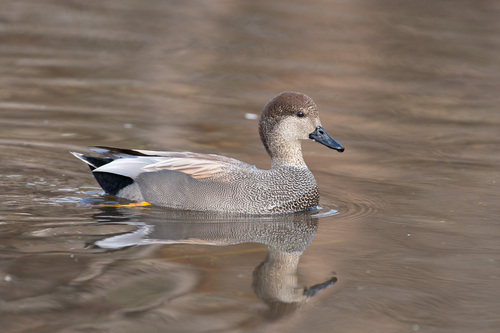
Gadwall
The Gadwall (*Mareca strepera*) is a dabbling duck of understated elegance, often overlooked due to its subtle plumage. Unlike some of its more brightly colored relatives, the Gadwall boasts a refined beauty, with males displaying intricate patterns of gray, brown, and black. It plays a vital role in wetland ecosystems, primarily consuming aquatic plants and contributing to seed dispersal. While not as widely recognized in popular culture as some ducks, the Gadwall holds a significant place in the Anatidae family and is appreciated by birdwatchers for its subtle charm and widespread distribution.
46-56 cm
Length
78-90 cm
Wingspan
Least Concern
Conservation Status
Distribution
The Gadwall has a wide distribution, breeding across North America, Europe, and Asia. It migrates south for the winter, reaching areas in the southern United States, Mexico, Central America, northern Africa, the Middle East, and southern Asia. Its altitudinal range extends from sea level to higher-elevation wetlands.
Lifespan
The average lifespan in the wild is 3-5 years, but some individuals can live much longer, with records exceeding 15 years.
Gadwall's Habitat
Habitat Types
Freshwater marshes, Lakes, Ponds, Slow-moving rivers, Brackish wetlands, Coastal lagoons
Climate Zones
Temperate, Boreal, Subtropical (wintering grounds)
Adaptations
Gadwalls are well-adapted to a variety of wetland habitats. Their lamellae (comb-like structures on the bill) help them filter small food items from the water. They are also strong fliers, enabling them to undertake long migrations.
Variations
There are no widely recognized subspecies, although slight variations in size and plumage may occur across its extensive range. The extinct Coues' Gadwall (*Mareca strepera couesi*) was previously considered a subspecies, it was endemic to Teraina, a raised atoll in the central Pacific, in the northern Line Islands.
Appearance
Breeding Plumage
Breeding males have finely patterned gray and brown plumage with a black rear end and a white speculum (wing patch). Non-breeding males (eclipse plumage) resemble females. Females are mottled brown year-round.
Seasonal Feather Changes
Males undergo a complete molt after breeding, adopting the eclipse plumage. They regain their breeding plumage in the fall.
Sex Based Plumage Differences
Significant sexual dimorphism exists in breeding plumage, with males being more intricately patterned and having distinct black and white markings.
Notable Features
White speculum visible in flight, Black undertail coverts in males, Relatively small, gray bill
Diet and Feeding
Primary Foods
Aquatic plants (leaves, stems, seeds), Submerged vegetation, Algae, Some aquatic invertebrates (insects, mollusks, crustaceans, especially during breeding)
Foraging Behavior
Gadwalls are primarily dabbling ducks, feeding by tipping their heads underwater to reach submerged vegetation. They also graze on land near water and occasionally dive.
Specializations
Their bill morphology is adapted for efficiently straining plant material from the water. The lamellae help filter out small food particles.
Seasonal Diet Variations
While primarily herbivorous, Gadwalls consume more invertebrates during the breeding season to meet the increased protein requirements of egg-laying and chick-rearing. The diet shifts back to predominantly plants during the non-breeding season.
Behavior
Social Structure
Gadwalls are generally gregarious, forming flocks outside of the breeding season. During breeding, they are more dispersed and territorial.
Communication
Soft quacks (female), Whistles and grunts (male), Visual displays (head-shaking, wing-flapping)
Migration
Gadwalls are migratory, traveling long distances between breeding and wintering grounds. They often migrate in mixed flocks with other duck species.
Territorial or Group Behaviors
Males defend a small territory around the nest site during the early stages of breeding. Outside of breeding, they form large flocks for foraging and roosting.
Conservation
Threats
Habitat loss and degradation (wetland drainage), Pollution of wetlands, Climate change (altered precipitation patterns, increased drought frequency), Hunting (in some regions)
Protection Programs
Wetland conservation and restoration projects, International treaties (e.g., Ramsar Convention on Wetlands), Migratory Bird Treaty Act (in North America)
Local National Laws
Protected under various national and international laws regulating hunting and habitat protection.
Population Trend
Stable
Population Estimates
The global population is estimated to be between 3.9 and 4.5 million individuals.
Interesting Facts
Gadwalls often steal food from other ducks.
They are known to snatch vegetation brought to the surface by diving ducks, a behavior called kleptoparasitism.
They are one of the latest-nesting duck species in North America.
Their breeding season often extends well into the summer months.
The Gadwall's scientific name, *strepera*, refers to its noisy call.
The Latin word 'strepera' means 'noisy' or 'clamorous'.
Faqs about Gadwall
What is the difference between a male and female Gadwall?
Breeding males have intricate gray and brown plumage with a black rear end, while females are mottled brown year-round. Non-breeding males resemble females.
Where can I see a Gadwall?
Gadwalls can be found in a variety of wetland habitats, including marshes, lakes, and ponds, across North America, Europe, and Asia. Check local birdwatching guides for specific locations.
Are Gadwalls endangered?
No, Gadwalls are classified as Least Concern by the IUCN, meaning their population is relatively stable.
What do Gadwalls eat?
Gadwalls primarily eat aquatic plants, but they also consume some invertebrates, especially during the breeding season.
Copyright @ Nature Style Limited. All Rights Reserved.
 English
English